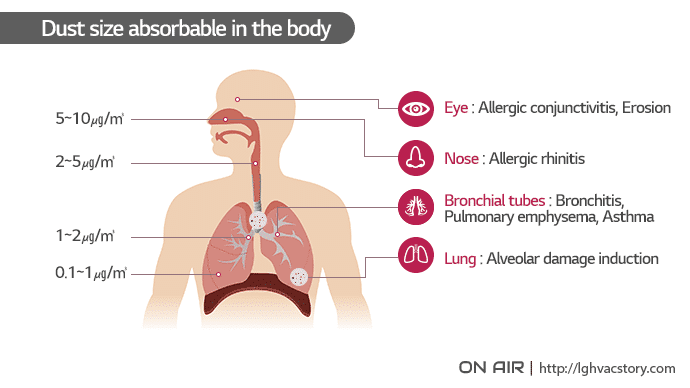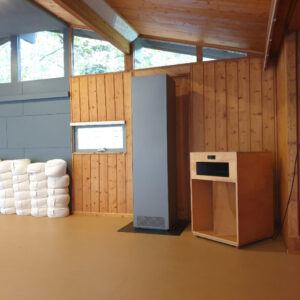We care about clean air
solutions for indoor air quality
Quick to: measure fine dust levels yourself
What is fine dust? How harmful is it to you?
You have probably heard something about fine dust(or particulate matter) in the news. However, what many people only know about fine dust is that it’s “a type of” air pollution and it’s unhealthy. But what exactly is fine dust? And what are the causes? Read more about it here. We’ll also give you information about how to protect yourself from these invisible dust particles.
What is fine dust exactly?
The definition of fine dust cannot be described unambiguously. The RIVM (more info) compares it to a “kind of junk box containing materials of different sizes and chemical compositions”.
Fine dust is really just a whole collection of very small particles in the air. When physically described, we talk about the size of the dust particles and the amount of m³ particles in the air that we breathe in. The dimensions that are generally used are PM10, PM2.5, PM1 and PM0.1. These particles are not visible to the naked eye.
PM comes from the English word particulate matter: a literal translation of fine dust. To get an impression of how small these different fine dust particles can be, it’s good to realize that the size of a human hair is PM70. The diameter of the largest fine dust particles found in the air are therefore already 7 times smaller compared to the size of a hair. This should give a good idea of how small particulate matter is.

You can also chemically define particulate matter. In that case we look at which components the particles in the air consist of. Components of fine dust include heavy metals (arsenic, lead, nickel), water, carbon, salts, acids and a wide variety of organic substances, often the result of incomplete combustion processes (e.g. exhaust fumes from road traffic, airplanes landing and taking off etc).
What are the causes of fine dust?
Fine dust can have a natural origin as well as that it is caused by human actions. Natural processes that cause dust in the air are forest fires, volcanic eruptions, the splashing of seawater and soil matter being taken by the wind (for instance the sand from the Sahara).
80% is caused by humans
Fine dust in the air often occurs as a direct cause of human actions. For example, approximately 80% of the concentration of fine dust particles in the air is caused by humans.
Traffic and transport come first, which is the largest emitter. Here exhaust fumes are given off from cars, freight traffic, airplanes and (large) ships. Not far behind is the industrial sector. Not only factories, but also refineries and power stations make a significant contribution to the fine dust problem. In addition, the agricultural sector also plays a serious role: no less than 90% of the emissions of ammonia, for example, are caused by agriculture.
A factor that has recently been receiving more and more attention is households themselves. We have a number of serious fine dust pollutants in our houses. Think about cleaning products, body care sprays, cooking, pets and wood stoves.

How harmful is it to my health?
The WHO (World Health Organization) speaks of 7 million deaths a year worldwide from exposure to fine dust. Figures like this do not reassure you. But it’s important to put them in perspective. How bad is the fine dust problem in the Netherlands? And where does it come from? An interesting comparison is that in the Netherlands approximately 600 people die in traffic and 800 people die from a short-term peak exposure to fine dust every year.
We learn more about the effects of fine dust everyday. In fact it’s all based on size: the smaller the particles, the more harmful. For example, particles of PM0.1 enter your bloodstream directly. The Dutch live about a year shorter due to the exposure to fine dust. Scientific research has shown that there is a connection between the exposure to fine dust and the following diseases and conditions: cardiovascular diseases, respiratory diseases (asthma, COPD), cancer and Alzheimer’s. Read more about air purifiers for asthma.
Anyone can get complaints
Some people are more likely to suffer from fine dust health problems than others. Children, the elderly and people with respiratory diseases are especially vulnerable. But you can also get complaints if you don’t belong to one of these groups. Think of people who are frequently exposed to exhaust fumes, like office workers along a highway. Even if you live close to Schiphol you can suffer from fine dust health problems. In fact, researchers from the RIVM have established that healthy adults in that region, experience short-term decreases in lung and heart function at times when there is a high concentration of ultrafine dust particles in the air (source).
What can you do against fine dust?
The smaller the particles, the deeper they can penetrate our body. And the deeper the particles, the more harmful they will be. What can you do about this? The answer: pay more attention to the air quality in your working and living environment.
The first step is to measure the amount of fine dust in the air. This is possible with a fine dust meter. The device accurately indicates the air quality level of your indoor space. After you’ve done this, you can take the right action and clean the air. The best way to do that is with a good air purifier. The air purifiers from Extreme Air Products help to keep the PM concentration in your work or living environment to a minimum.

Do you need advice or more information?
According to the Dutch Lung Fund (Longfonds), the air quality in 1 in 7 houses is insufficient due to fine dust. By measuring fine dust you gain insight into the air quality in your environment. You can also determine the effectiveness of your air purifier. View our product page about the particulate matter meter or read more about the fine dust meter in our extensive advice. Do you have any further questions or would you like some free advice? Call +31 20 6464028. Or go directly to our range of fine dust meters:

